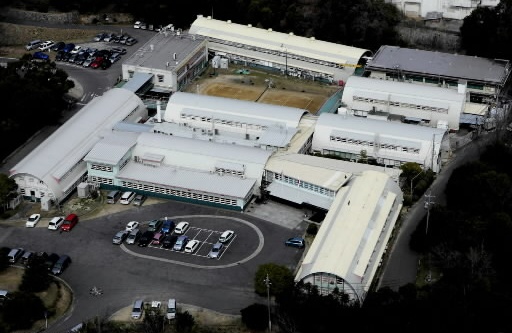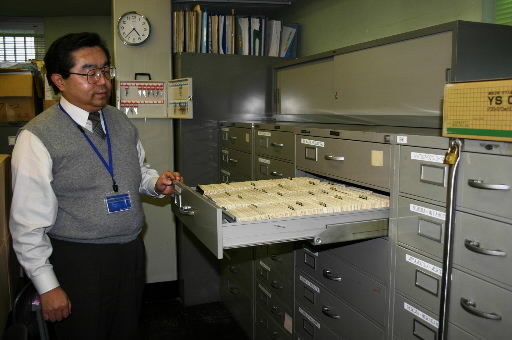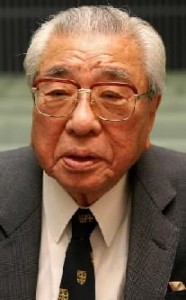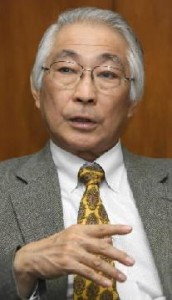Special Series: 60 Years of RERF, Introduction
Jun. 30, 2010
Studies on A-bomb survivors draw attention and criticism
by Hiromi Morita and Masayoshi Ishikawa, Staff Writers
This feature series on the past and future of the Radiation Effects Research Foundation (RERF) originally began to appear in the Chugoku Shimbun in February 2007.
The Radiation Effects Research Foundation (RERF) in Minami Ward, Hiroshima, will soon mark the 60th anniversary of its establishment. The results of RERF studies on A-bomb survivors (hibakusha) that have accrued since RERF was still the Atomic Bomb Casualty Commission (ABCC) have drawn international attention. These research results have also been used for standards for radiation protection. Meanwhile, RERF, which was established by the United States, the nation which dropped the atomic bombs, and is jointly operated by Japan and the United States, has caused discomfort among a large number of hibakusha. The prospects for RERF operations are uncertain, now that the survivors, the subjects of its studies, are aging and the institute is affected by financial difficulties. The Chugoku Shimbun has summarized the history and current circumstances of RERF.
The RERF buildings stand on Hijiyama Hill, overlooking the city of Hiroshima. The institute's staff currently numbers about 300. "Please don't hesitate to tell us if there are any examinations you don't like," an RERF staff member said, explaining the procedures in detail to a survivor visiting the facility for a health checkup.
For over half a century, RERF has been conducting long-term studies on hibakusha who have agreed to take part. Through these studies, RERF has discovered that higher doses of radiation have led to a higher incidence of cancer, including leukemia, and higher mortality rates associated with the disease. The studies have also confirmed that higher doses of radiation led to the increase of microcephaly with regard to hibakusha who suffered prenatal exposure to the bomb's radiation while in their mothers' wombs.
RERF has also turned its attention to lifestyle-related diseases recently and undertaken research on the human genome. The institute is pursuing a connection between radiation exposure and non-cancer diseases, such as cardiovascular disturbance, diabetes, hepatitis B and hepatitis C. The results of the health effects study on second-generation A-bomb survivors, which began in May 2001, will be released on February 28.
RERF's predecessor, ABCC, was established in 1947 by the U.S. National Academy of Sciences and the U.S. National Research Council with funds granted by the U.S. Atomic Energy Commission. A portion of the Hiroshima Red Cross Hospital was leased for the institute, which began its research with hematological tests. In 1975, the institute was transformed into a cooperative Japan-U.S. foundation. Over the years, RERF has faced criticism in that it "only conducts research and provides no medical treatment to the survivors." However, the institute now convenes meetings of the Hiroshima Local Liaison Council, comprised of hibakusha and local government officials, and asks for understanding for its "peaceful purposes" and "pure academic research."
The institute is faced with a number of challenges in order to continue its research. The number of surviving hibakusha who are the subjects of RERF's research programs has decreased almost by half. Other problems include transferring out of the aging facilities, securing young researchers, and financial constraints. The Joint Senior Review Group, comprised of experts from both Japan and the United States, is holding discussions to explore the future vision of RERF to ensure the institute's survival.
Eiichi Tahara, a member of the Joint Senior Review Group and director of the Hiroshima Cancer Seminar Foundation, noted, "RERF needs to carry out further research to remove the anxieties of hibakusha, including research on exposure to low-level radiation and the effects of radiation on second-generation A-bomb survivors. Early diagnoses of radiation-induced diseases and the development of a system that will be used for medical treatment are vital."
Main research programs of RERF
Life Span Study and Adult Health Study
These programs serve as a vital foundation for shedding light on the effects of radiation exposure on human health. The life span study investigates the causes of death of about 120,000 people: Roughly 94,000 people identified as hibakusha by the 1950 national census and 26,000 non-hibakusha, which includes people who were exposed to residual radiation by entering the cities of Hiroshima and Nagasaki after the atomic bombings. From the total of 120,000 people, RERF has selected about 23,000 individuals for the adult health study, which began in 1958, and provides the participants with medical examinations through interviews and health checkups once every two years.
The analyses of the research results on the correlation between radiation and the incidence of diseases, based on the radiation doses estimated from the location of hibakusha at the time of the bombing, have demonstrated the effects of radiation on the incidence of leukemia and other cancers such as stomach cancer and lung cancer. The correlation between radiation and diseases, such as hepatitis B, hepatitis C and diabetes, have yet to be clarified.
In Utero Study
About 3,600 people, including non-hibakusha and hibakusha who were exposed to the atomic bombings in utero, are the subjects of this study. The research conducted up to the 1960s has confirmed the increase of microcephaly and mental retardation. In 1967, the former Ministry of Health and Welfare recognized that these symptoms were induced by radiation and, under the name of "short-distance early prenatal exposure syndrome," included the disease in the designated A-bomb diseases that are eligible for public assistance.
Children of Atomic-bomb Survivors Study
Since the six-year research project that had its beginning in 1948, which focused on the deformities, stillbirths, and immediate post-delivery deaths of about 77,000 newborn babies, including non-hibakusha, the research on second-generation A-bomb survivors has continued. Follow-up surveys on 88,000 second-generation A-bomb survivors, who were born between 1946 and 1984, have been carried out. Though research on chromosomal abnormalities and protein change was also conducted, the effects of the parents' radiation exposure on the health of second-generation A-bomb survivors remain unproven at this point.
Now that many second-generation A-bomb survivors have reached middle age, RERF launched an effort in 2001 to study the correlation between radiation and the incidence of lifestyle-related diseases, such as diabetes and high blood pressure.
For the research, questionnaires were first sent by mail to ask about the respondents' personal habits, such as drinking, smoking and exercise, and roughly 12,000 people underwent health checkups by last September. The results of the analyses will be released on February 28.
Atomic-bomb Dosimetry Individual radiation doses are estimated based on the locations of hibakusha at the time of the bombing and the total amount of radiation emitted by the atomic bombs. The first dosimetry system, dubbed "T65D" for Tentative 1965 Dosimetry System, was developed that year. T65D was later replaced by the Dosimetry System 1986, or "DS86," and then by the Dosimetry System 2002, or "DS02," which is the system now in use.
RERF has devised the formula based on radiation doses measured by A-bomb samples, including metal objects and roof tiles, which were collected near the hypocenter. Depending on the circumstances of the radiation exposure of the subjects of the life span study whom RERF has interviewed, the effects of the shielding, if the interviewees experienced the atomic bombing inside a building or in the shade of an object, is taken into account. The dosimetry system is used by the national government for the A-bomb disease certification criteria.
Itsuzo Shigematsu, former RERF director, speaks about RERF's obligation to continue its observations of the A-bomb survivors
Itsuzo Shigematsu, 89, an honorary advisor to RERF and a Tokyo resident, served as RERF chairman for 16 years from 1981. "The 60th anniversary of the establishment of RERF will not mark the end of the institute. RERF's research will move forward from here." He holds high hopes for his successors.
Including the period when RERF was ABCC, Dr. Shigematsu has been the longest-serving chairman. On the basis of epidemiological research on hibakusha, he led RERF's studies and broadly conveyed the reality of radiation exposure: "Not simply by appealing for the elimination of nuclear weapons but by attracting international attention to the research results obtained in the A-bombed city, we can transmit the horror of nuclear weapons."
During his tenure, the hardest task was securing first-rate researchers. When he frequented ABCC as an epidemiologist, "There were excellent American researchers at ABCC who were also passionate about peace issues and had rejected the draft during the Vietnam War," Dr. Shigematsu revealed.
During Dr. Shigematsu's tenure as chairman, one event had a particularly strong impact on the institute. The circumstances were certainly regrettable, but the nuclear accident at Chernobyl in 1986 made RERF's accomplishments known to the world. The former Soviet Union sent a team of investigators to RERF the following year and asked for guidance.
However, estimating the level of radiation doses was a complex task, partly due to the victims' indirect inhalation of radioactive materials that had been released over a period of 10 days as well as the fact that, unlike with Hiroshima, the environment was different and the victims were more spread out. Thus, the research conducted in the A-bombed city could not be applied in the same way to Chernobyl. Above all, Dr. Shigematsu became keenly aware of the difficulty involved in gaining the understanding of local residents for the research. "Hiroshima was able to obtain the cooperation of hibakusha," he said, looking back on RERF's research. "That was a big difference."
Some have pointed out that RERF's research data, which began to be gathered during the chaotic period after the war, has underestimated the effects of radiation exposure. RERF's category of non-hibakusha, whose data are compared to those of hibakusha, includes people who may have been exposed to residual radiation. ABCC chose its research subjects based on the 1950 national census, excluding those who had died within the five years since the atomic bombings occurred. It may be the case, though, that "resilient hibakusha" were among the survivors.
"It's only natural that such problems have been pointed out," Dr. Shigematsu said. "At the same time, we have continued our research to address these concerns one by one. RERF must persist in its efforts and, at the very least, should observe the health conditions of hibakusha to the last survivor. If the institute devotes itself to hibakusha that far, the world will ultimately accept the important role that we have played."
Interview with RERF chairman Toshiteru Okubo on the institute's future course and prospects for research
The Chugoku Shimbun interviewed Toshiteru Okubo, the RERF chairman, on the future course and prospects for research at RERF, now at a crossroads.
How do you view the past 60 years?
The history of the institute is heavy in the sense that it has been built upon grave sacrifices. One has to admit that there was a period when ABCC leaned toward military purposes, partly due to U.S. military intervention during the occupation period. It's also true that these 60 years have instilled some bad feelings and bad images in the minds of survivors. However, RERF has been able to carry out its research in a way that rejects any intervention by other entities, thanks to the cooperation of many hibakusha and the all-out efforts made by our senior researchers and staff members. The results are being used to protect humanity from radiation.
With the A-bomb survivors growing old, RERF's mission is being called into question.
As hibakusha who were exposed to the atomic bombings in their early youth are approaching the cancer-prone age, the institute needs to continue its research over the next 20 to 30 years. For half a century, RERF has stored 577,006 frozen samples of blood and urine, as well as 932,250 pathological tissue samples, including cancer tissue. Even after RERF's research projects directly involving hibakusha, such as health checkups, come to an end, RERF can conduct research beneficial for human beings in the future through the use of these samples.
The transfer of the RERF facilities seems to have stalled.
This is related to a long-term plan pursued by the City of Hiroshima. The Forum for Institutes Engaged in A-bomb Survivors' Medical Care compiled an interim report seeking the transfer of the RERF facilities to increase collaboration among the institutes. Besides its location, the aging buildings also pose a problem. Though the transfer involves diplomacy with regard to determining how to divide the financial burden between Japan and the United States, we hope to find a solution that will allow us to make the best use of the wisdom accumulated to date.
I understand that securing young researchers is also a challenge.
Without a clear future vision for the institute, young people are reluctant to make a long-term commitment to RERF. In cooperation with other institutes, we plan to promote personnel exchanges and join research. For instance, RERF can be an institute with a training function where young researchers with doctorates can come to study for several years.
What value is there in maintaining the joint operation of RERF by Japan and the United States?
RERF was the only institute established amid rising anti-American sentiment and, despite the mixed feelings that spread among local citizens, the tireless efforts made by hibakusha and researchers from Japan and the United States have sustained the institute. The experiences of the A-bombed cities, involving the hardships of the hibakusha and the history of the peace movement, must not be divorced from the research at RERF. The joint operation also serves as a continual reminder to the United States of Hiroshima. We will not turn our backs on the dark history of the past. At the same time, we seek to face the future squarely.
Toshiteru Okubo
Dr. Okubo was born in Tokyo in 1939. After graduating from the School of Medicine at Keio University, he served as associate professor at Jichi Medical University and as professor and president at the University of Occupational and Environmental Health. In April 2005, Dr. Okubo assumed the post of RERF vice chairman, and then his current post of chairman in July of the same year. He specializes in public health and epidemiology.
History of ABCC/RERF
August 1945
Atomic bombs were dropped on Hiroshima and Nagasaki.
September 1945
Japanese medical teams and scientists from the United States established the Joint Commission.
November 1946
U.S. President Harry Truman ordered the National Academy of Sciences and the National Research Council to conduct long-term research on hibakusha. Four experts entered Hiroshima 10 days later.
March 1947
The Atomic Bomb Casualty Commission (ABCC) was established at the Hiroshima Red Cross Hospital.
January 1948
The Hiroshima Branch of the Japanese National Institute of Health (JNIH) of the Ministry of Health and Welfare formally joined the ABCC studies.
October 1950
A national survey of A-bomb survivors was conducted as a supplement to the national census. Roughly 290,000 hibakusha were confirmed nationwide.
November 1950
The relocation of ABCC began to Hijiyama Hill.
April 1952
Japan regained its independence.
November 1955
The U.S. Atomic Energy Commission (now, the U.S. Department of Energy) and the Francis Committee, comprised of members of the National Academy of Sciences and the National Research Council, proposed a drastic review of ABCC research design.
July 1958
The adult health study commenced.
August 1958
ABCC and JNIH exchanged written agreement to conduct the life span study. The basis of a cooperative U.S.-Japan research system was established.
April 1975
ABCC and JNIH were reorganized and the Radiation Effects Research Foundation, a Cooperative Japan-U.S. Research Organization, was established.
December 1978
Autopsies on hibakusha were discontinued.
March 1986
"T65D," the tentative estimates of radiation doses of the atomic bombs, was revised, and the dosimetry system "DS86" was developed.
October 1990
RERF organized a meeting of the World Health Organization (WHO) Scientific Advisory Committee on the Chernobyl accident.
October 1995
RERF organized a meeting of the WHO Radiation Emergency Medical Preparedness and Assistance Network.
June 1996
The Blue Ribbon Panel presented the recommendation on RERF's future studies that RERF prioritize epidemiological research.
October 1999
RERF participated in a health study of residents living in the vicinity of the Tokaimura Village criticality accident.
May 2001
The health study of A-bomb survivors' children commenced.
March 2003
Final approval was obtained for the new dosimetry system "DS02," which would succeed "DS86."
November 2005
The Japanese and U.S. governments agreed to establish the "New Blue Ribbon Panel" in 2006, a third-party committee to determine the future course of RERF.
July 2006
RERF concluded a comprehensive cooperation agreement with Hiroshima University.
October 2006
RERF announced that its agreement with the National Institute of Radiological Sciences, Hiroshima University, and Nagasaki University to create a common database. The Forum for Institutes Engaged in A-bomb Survivors' Medical Care formed and compiled local requests mainly calling for the transfer of the institute to downtown Hiroshima.
December 2006
RERF announced that 11,951 people underwent the health checkups for second-generation A-bomb survivors by the end of September. "The Joint Senior Review Group," a third-party group in which RERF's future course for the next 20 years is discussed, was held.
(Originally published on February 26, 2007)











